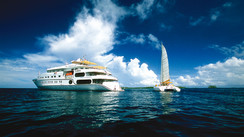French Polynesia - Maupihaa, or being in perfect harmony with nature
Destination - CaribbeanA few hundred nautical miles to the west of Tahiti, lies the magnificent atoll of Maupihaa or Mopélia, the last outpost of French Polynesia as you head towards the setting sun. Accessible only by sea through a narrow channel where currents can quickly get the better of lightly powered vessels, Maupihaa also meets all the criteria of a paradisiacal Polynesian atoll. Its vast beaches stretch for several miles, lined with coconut palms and endless reefs.
Only around twenty people live self-sufficient lives on the atoll, in perfect harmony with nature. With no grocery shops, they depend solely on their coconut palms and the crabs that hang from them. The island’s main activity is the production of copra, the dried white flesh of the coconut. All the inhabitants work in this industry; they have to harvest 25 tons before the supply ship will come from Maupiti to collect the crop and supply flour, sugar, rice and a few other staples for the coming months. This boat arrives approximately every 3 to 4 months - if the copra production has been good.
This is where we discover that the coconut palm really is ‘the tree of life’, as the locals call it. In addition to its picture-postcard image, the coconut tree can provide water, food, oil, natural medicines, building materials and much more.
The Polynesians are excellent fishermen, and don’t hesitate to take visitors fishing for lobster at night on the reef. Antonio, an expert in this field, moves skillfully between the mounds of coral, in his sandals that are full of holes. He can effortlessly collect several lobsters a minute. Despite the shallow depths, he cheerfully warns of the risk of lemon sharks, which can be aggressive at night.
The atoll is also teeming with coconut crabs, which are much easier to catch. The Polynesians are fully aware of the impact of overfishing and know how to regulate their atoll’s ecosystem by carefully selecting their catches.
This is a truly fabulous stopover, as much for the social aspect as for the beauty of the place.
TO SEE / TO DO
Maupihaa is a wild atoll with a magnificent eco- system, both on the land and under the water. It is home to a wide variety of seabirds, including red-footed boobies, terns, noddys and tropicbirds. These species find the atoll’s pristine beaches ideal for nesting and laying their eggs.
It’s fascinating to venture into the brush and interact with these birds - while respecting their privacy and habitat, of course. These islands, which are still far from large population centers, suggest that there is perhaps no real barrier between us humans and the rest of nature.
The inhabitants of Maupihaa are incredible people, with a generosity that was unparalleled when I was lucky enough to meet them. They didn’t hesitate to share their skills and impart their invaluable knowledge. I had the opportunity to take part in harvesting copra with them, as well as bagging it before the supply boat arrived. To produce copra, the coconuts are opened to extract the white flesh. This is then dried in the sun until it reaches a moisture content of just 6-10%.
The copra obtained this way is a raw material used in a variety of areas. Its main use is in the production of copra oil, which is widely used in the food, cosmetics and pharmaceutical industries.
Maupihaa is above all a place for sharing culture and activities in the heart of nature. Diving, fishing, hunting, gathering: these activities teach us a lot about the simple pleasures of life, which really can be enough to make us happy - yes, it’s true!
ANCHORAGE
No swell, a light breeze moderated by the coconut palms, three meters (10 feet) of sandy seabed and water so translucent you can see the seashells crawling along the bottom... as you can see this is a beautiful and safe anchorage. There’s no denying it, there’s absolutely nothing or almost nothing to fear in a place like this.
The swell fluctuates between south- east and north-east. The channel faces west, making it relatively easy to cross despite its narrowness and the sometimes strong current. What’s more, the atoll’s main island provides complete protection from the swell.
The anchorage to the south-east of the atoll is without doubt my favorite, although you can moor wherever you like once you’re inside. 16°49.710‘S - 153°55.564’W
WEATHER
The weather in French Polynesia is generally characterized by a hot, humid tropical climate, with relatively subtle seasonal variations.
There are two main seasons: the hot, humid season (November to April) and the cool, dry season (May to October).
During the wet season, temperatures are generally higher and rainfall more frequent. This is also the period when tropical storms and cyclones can occur - although less frequently than in the Caribbean. The dry season, on the other hand, is marked by more moderate temperatures and less rainfall.
The prevailing trade winds are generally from the south-east or east, usually bringing stable weather and pleasant conditions, particularly during the dry season.
These winds are stronger during the wet season, when the weather systems are more active.
The weather is pleasant all year round, with daytime averages generally fluctuating between 25°C and 30°C.







Destinations offered by
View all the destinations
 Discover the 2025 winners!
Discover the 2025 winners! 













What readers think
Post a comment
No comments to show.